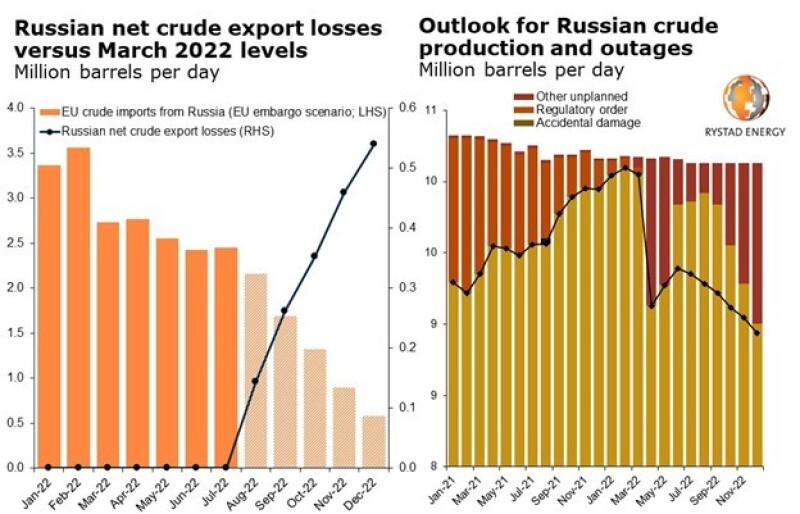A million down. A million up. A million down, again.
This roughly describes the rollercoaster ride in oil production that Russia is expected to see fully play out in the coming months, according to a new forecast from Rystad Energy.
Despite showing a measurable degree of resilience since sanctions began hitting a few months ago, the Oslo-based market research group said this week that “the worst is yet to come” for the Russian oil industry.
Rystad's analysis shows that Russia likely saw production drop by as much as 1 million B/D in April before making an almost complete rebound by July as crude output neared pre-war levels. Rystad said this “outstanding growth” was largely the result of increased refinery throughput as exports topped out at 5 million B/D April and May before retreating to 4.2 million B/D last month.
These figures led Rystad to increase its outlook for Russia’s average production this year by 200,000 B/D to 9.6 million B/D. However, the impressive comeback may be short lived.
As summer concludes in Russia, Rystad expects crude production will drop once again by as much as 1.1 million B/D and that a “further recovery will be more challenging and will take more time.”
Another looming cloud are the sanctions approved in May by the European Union (EU) that target about 90% of the 22-member states’ combined imports of Russian oil and gas products. Seaborne oil and gas products were immediately banned with notable exceptions including pipeline imports to Germany and Poland that are scheduled to be phased into the embargo in December.
Rystad does not consider it likely that compliance with the EU embargo will be total during the start of 2023. But it does project that EU imports of Russian crude will drop to 600,000 B/D by December. Before its invasion of Ukraine 6 months ago, Russia was supplying the EU with an average of 3 million B/D. Rystad noted that with the deadline to comply with the embargo approaching, Russian exports to the EU were slightly up last month.

The research firm also pointed out that last month saw lower volumes of Russian exports to Asian markets. This may spell trouble for Russia in the coming months since it is depending on Asian buyers to absorb the nearly 2.5 million B/D that is soon to be displaced by EU sanctions.
Rystad noted that while exact reasons cannot be confirmed, the dip in exports to Asia could be due to “less generous” discounts on Russian crude. At least one price-reporting service has noted that Russia’s Urals oil blend discount to Brent Crude has fallen from a range of about $40/bbl–$30/bbl to $15/bbl.
On the domestic front, these discounts apply to Russian refineries as well which has helped prop up demand nationwide. Rystad also noted that with many international destinations closed or restricted to Russian travelers, seasonal domestic consumption for gasoline is higher than normal as many opt for road trips this year.
The ability for the domestic market to keep absorbing the excess may soon vanish since Russia’s central bank has issued a warning that the nation’s economy is set to shrink by as much as 8% year-over-year in the third quarter. This could worsen into a deeper recession of 10% to 11% in negative growth by the final quarter of the year.
Rystad believes such an economic crisis would quickly translate to lower refinery utilization, which it estimates may be at 5.2 million B/D by December—a year-over-year drop of 700,000 B/D.


